PROCAS Mobile Time Overview
Once logged into the system, your timesheet will populate for the current day, with your default charge codes on display. An example can be seen below, which will be broken down piece by piece.
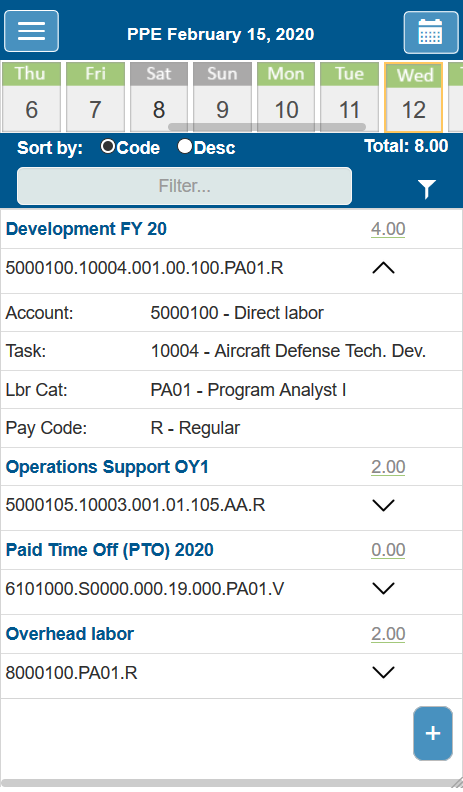
PROCAS Mobile Time Header
The timesheet header provides context to what is being presented in the body of the timesheet, as well as functional buttons for navigating throughout the system:
![]() – Hamburger Menu
– Hamburger Menu
- Allows the end user to enter today’s time, see their timesheet summary, submit their timesheet, or log out.
- See below section Other PROCAS Mobile Time Options for utilizing these additional functions.
![]() – Pay Period
– Pay Period
- Displays current pay period and allows for the end user to toggle to any prior open period.
![]() – Pay Period End Date
– Pay Period End Date
- Displays when the current pay period ends for the end user to see when they have to submit their timesheet.
![]() – Total Time for Current Day
– Total Time for Current Day
- Sums up the hours recorded on the current day for a total across all used charge codes.
![]() – Date Range Slider
– Date Range Slider
- Allows end user to scroll left or right across days of the available pay period with the touch of a finger.
![]() – Sort & Filter Functions
– Sort & Filter Functions
- Sort – Toggle controls end user’s preference to sort their timesheet by charge code or by charge code description.
- Filter Box – Text box limits what charge codes end user sees by typing in specific words or phrases. Helpful for searching for specific codes or descriptions from the available list of charge codes.
PROCAS Mobile Time Detail
The timesheet detail provides available charge code information as well as the ability to enter daily time. This section describes important aspects of using a DCAA compliant timekeeping system and passing DCAA timekeeping audits.
 – Consolidated Charge Code
– Consolidated Charge Code
 –Charge Code Description
–Charge Code Description
- Describes the contract/task for which work is performed.
- Describes the contract/task for which work is performed.
- – Charge Code
- Concatenation of Account, Task, Labor Category, & Pay Code (see breakdown below).
- Concatenation of Account, Task, Labor Category, & Pay Code (see breakdown below).
 – Hours Recorded
– Hours Recorded
- Total hours recorded for each charge code.
- To add/remove/modify time, please select the number of hours recorded.
 – Drop Down Carrot
– Drop Down Carrot
- Expands the consolidated charge code screen into the expanded view below.
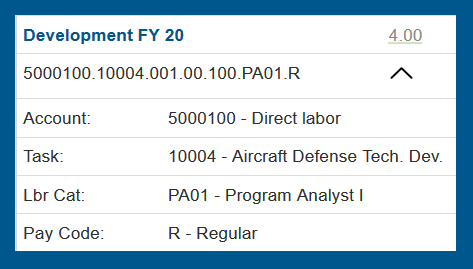 – Expanded Charge Code
– Expanded Charge Code
Established by accounting staff, the codes below are combined to make up the overall charge code.
- Account – Type of labor performed, either direct (for a contract) or indirect (fringe, overhead or G&A)
- Task – Contract/project being completed at the work breakdown level
- Lbr Cat – Type of work performed for the contract, signified by a labor category
- Pay Code – Type of pay due to the employee (regular, overtime, straight-time overtime, leave without pay, etc.)
 – Add Time
– Add Time
- Shows all available charge codes for the end user to select when inputting time.
- Only charge codes marked as ‘default’ will appear on the timesheet upon logging into the system.
- All other available charge codes will need to be picked using this button.
- To change your ‘default’ charge codes, you must access your timesheet via the desktop version of timekeeping.
Entering Time
Entering time in our new mobile optimized software can be done two ways:
1) Default Charge Codes – Simply select the hours ![]() on the appropriate charge code.
on the appropriate charge code.
2) Other Charge Codes – Must select the ![]() icon to find all other charge codes not marked as default. Find the appropriate charge code in this list and select the description
icon to find all other charge codes not marked as default. Find the appropriate charge code in this list and select the description ![]() in the title.
in the title.
Both options will lead to the below screen for time entry.
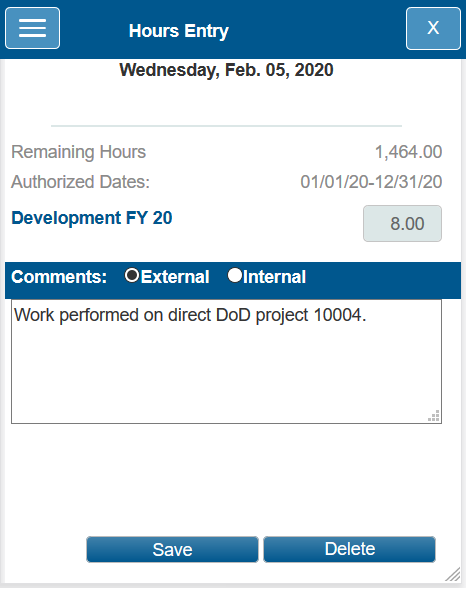
On this screen, you will see the following two informational pieces:
![]() – Remaining Hours on Project/Contract
– Remaining Hours on Project/Contract
- Budgeted hours set by administrative staff less hours already recorded against charge code.
- Hours remaining for employee to use for each charge code.
![]() – Authorized Dates to charge against Project/Contract
– Authorized Dates to charge against Project/Contract
- Dates set by administrative staff for which employees can record time against charge code.
And will have the following two functions to complete time:
![]() – Hours Input
– Hours Input
- Select this box and enter time worked for the day.
 – Comments
– Comments
- External – Optional comments for administrative staff to use on documentation being sent out of the system.
- Internal – Optional comments for approver to see specifics related to the work being performed.
Once hours (required) and any comments (optional) have been entered, select Save to record time on your timesheet. This process can be done for as many charge codes as needed per day.
Audit Trail of Changes
If previously entered hours or comments are changed or deleted, the system will require that the user add a reason for the change/deletion. This reason and the change/deletion are then added to an audit trail, which is available for supervisors, managers, and auditors to see.
Other PROCAS Mobile Time Options
By selecting the hamburger menu in the upper left hand corner, the end user will be presented with the following options:
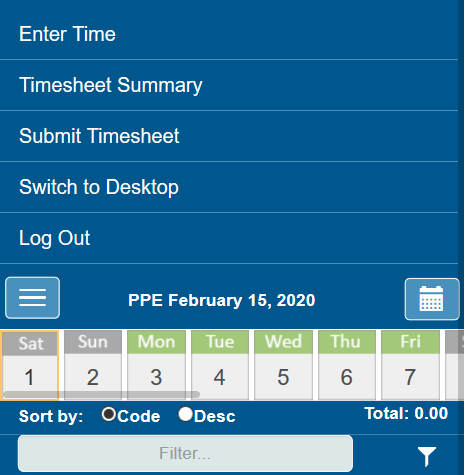
1) Enter Time – If selected, user will be taken to today’s time entry screen.
2) Timesheet Summary – Once selected, user will be presented with an expandable date view for time entered for each charge code (see below screenshot under Submit Timesheet).
3) Submit Timesheet – This menu presents the user with the view referenced in Timesheet Summary with the addition of a submit button at the bottom, which allows the user to submit their overall timesheet for the current pay period selected.
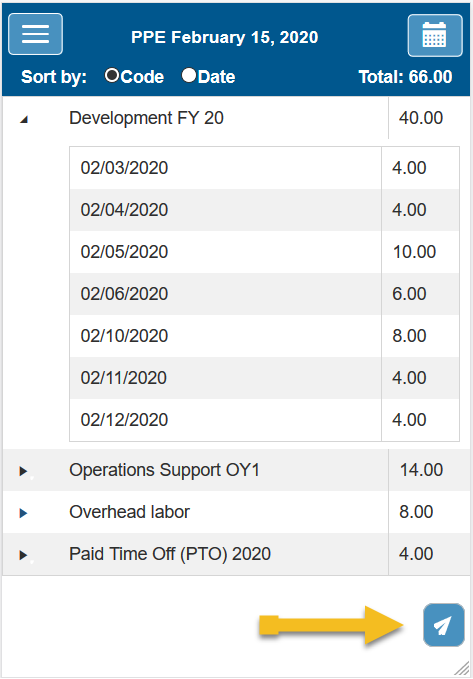
Once the submit button is selected, a notification screen will pop up to confirm that the time entered for the period is true and accurate.
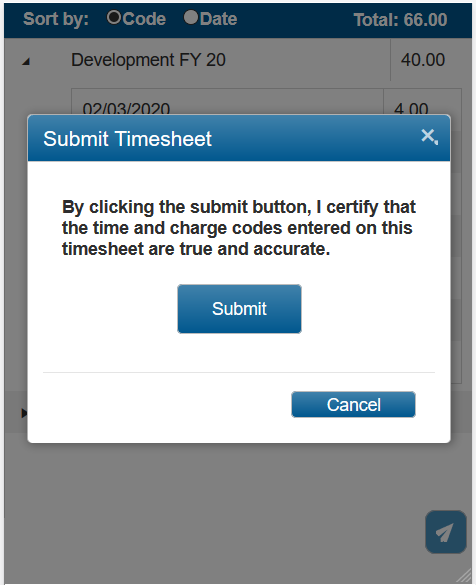
At this point, the user will confirm that they want to submit their time, or if they need to make any adjustments.
4) Switch to Desktop – If selected, the user will be switched over to the original desktop version of PROCAS Timekeeping. This option is recommended if the user is looking for a menu option that is not yet available in PROCAS Mobile Time.
5) Log Off – If selected, the user will be completely logged out of the system.
- Additional ways to log out of the system include:
- Closing out of your web browser
- Sitting idle on the timekeeping screen for 60 minutes.
Note – Letting your phone go to the lock screen should NOT log you out of the system unless you have hit the timeout limit.
Additional Help
For any additional feature requests, please submit emails to feedback@procas.com.
As always, operating DCAA compliant timekeeping software not only incorporates the software itself, but how it is used. Please be sure to check with your administrative staff for an explanation of how your policies and procedures align with our government contract timekeeping system.